#saint francis xavier
Explore tagged Tumblr posts
Text

#catholic saint quotes#catholic#saint quotes#saints#catholicism#tradcath#traditional catholic#love quotes#life quotes#christian quotes#st. francis xavier#san francisco savior#benedict medal#saint francis xavier#st francis xavior quotes#st francis xavier
3 notes
·
View notes
Text
SAINT OF THE DAY (December 3)

On December 3, the Roman Catholic Church honors St. Francis Xavier, one of the first Jesuits who went on to evangelize vast portions of Asia.
Francis Xavier was born on 7 April 1506 in the Kingdom of Navarre, a region now divided between Spain and France.
His mother was an esteemed heiress while his father was an adviser to King John III.
While his brothers entered the military, Francis followed an intellectual path to a college in Paris. He studied philosophy and later taught it after earning his masters degree.
In Paris, the young man would discover his destiny with the help of his long-time friend Peter Faber and an older student named Ignatius Loyola — who came to Paris in 1528 to finish a degree and brought together a group of men looking to glorify God with their lives.
At first, personal ambition kept Francis from heeding God's call. Ignatius' humble and austere lifestyle did not appeal to him.
But the older student, who had undergone a dramatic conversion, often posed Christ's question to Francis:
“What will it profit a man to gain the whole world and lose his own soul?”
Gradually, Ignatius convinced the young man to give up his own plans and open his mind to God's will.
In 1534, Francis Xavier, Peter Faber, and four other men joined Ignatius in making a vow of poverty, chastity, and dedication to the spread of the Gospel through personal obedience to the Pope.
Francis became a priest in 1537. Three years later, Pope Paul III confirmed Ignatius and his companions as a religious order — the Jesuits.
During that year, the king of Portugal asked the Pope to send missionaries to his newly-acquired territories in India.
Together with another Jesuit, Simon Rodriguez, Francis first spent time in Portugal caring for the sick and giving instruction in the faith.
On his 35th birthday, he set sail for Goa on India's west coast.
There, however, he found the Portuguese colonists causing disgrace to the Church through their bad behavior.
This situation spurred the Jesuit to action.
He spent his days visiting prisoners and the sick, gathering groups of children together to teach them about God, and preaching to both Portuguese and Indians.
Adopting the lifestyle of the common people, he lived on rice and water in a hut with a dirt floor.
Xavier's missionary efforts among them often succeeded, though he had more difficulty converting the upper classes and encountered opposition from both Hindus and Muslims.
In 1545, he extended his efforts to Malaysia, before moving on to Japan in 1549.
Becoming fluent in Japanese, Francis instructed the first generation of Japanese Catholic converts.
Many said that they were willing to suffer martyrdom rather than renounce the faith brought by the far-flung Jesuit.
St. Francis Xavier became ill and died on 3 December 1552, while seeking a way to enter the closely-guarded kingdom of China.
He was beatified by Paul V on 25 October 1619.
On 12 March 1622, both Francis Xavier and Ignatius Loyola were canonized by Pope Gregory XV.
Pius XI proclaimed him the "Patron of Catholic Missions."
9 notes
·
View notes
Text


THE DESCRIPTION OF SAINT FRANCIS XAVIER The Patron of Foreign Missions Feast Day: December 3
"Many, many people hereabouts are not becoming Christians for one reason only: there is nobody to make them Christians."
He was born Francisco de Jasso y Azpilicueta on April 7, 1506 at Javier, Kingdom of Navarre in northern Spain to an influential noble family. He was the youngest son of Don Juan de Jasso y Atondo, Lord of Idocín, president of the Royal Council of the Kingdom of Navarre, and seneschal of the Castle of Xavier and Doña María de Azpilcueta y Aznárez, sole heiress to the Castle of Xavier. Miguel de Jasso (later Miguel de Javier), his brother, became Lord of Xavier and Idocín at the death of his parents.
In 1512, Ferdinand, King of Aragon and regent of Castile, invaded Navarre, initiating a war that lasted over 18 years. Three years later, Francis's father died when Francis was only nine years old. In 1516, Francis's brothers participated in a failed Navarrese-French attempt to expel the Spanish invaders from the kingdom. The Spanish Governor, Cardinal Cisneros, confiscated the family lands, demolished the outer wall, the gates, and two towers of the family castle, and filled in the moat. In addition, the height of the keep was reduced by half.
In 1525, Francis went to study in Paris at the Collège Sainte-Barbe, University of Paris, where he spent the next eleven years. In the early days he acquired some reputation as an athlete and a high-jumper. Four years later, Francis shared lodgings with his friend Pierre Favre. A new student, Íñigo López de Oñaz y Loyola (later Ignatius of Loyola), came to room with them. At 38, Ignatius was much older than Pierre and Francis, who were both 23 at the time. Ignatius convinced Pierre to become a priest, but was unable to convince Francis, who had aspirations of worldly advancement. At first, Francis regarded the new lodger as a joke and was sarcastic about his efforts to convert students. When Pierre left their lodgings to visit his family and Ignatius was alone with Francis, he was able to slowly break down Francis's resistance. In 1530, Francis received the degree of Master of Arts, and afterwards taught Aristotelian philosophy at Beauvais College, University of Paris.
Francis began his study of theology in 1534 and was ordained on June 24, 1537. In 1539, after long discussions, Ignatius drew up a formula for a new religious order, the Society of Jesus. Ignatius's plan for the order was approved by Pope Paul III in 1540.
Francis was sent as a missionary to India. After a voyage of 13 months, he began preaching in the Portuguese colony of Goa (a state on the southwestern coast of India within the Konkan region), defending the natives from injustices and abuses. He was particularly outraged that some masters counted the blows inflicted on the slaves on the beads of their rosaries. Five months later, he preached with such enthusiasm among the Paravas on the Pearl Fishery Coast that most of them asked to be baptized. He also knew how to accept defeat, as when he preached for 12 months among the Brahmans obtaining only one conversion.
In Malacca in December 1547, Francis Xavier met a Japanese man named Anjirō (or Yajirō). had heard of Francis in 1545 and had travelled from Kagoshima to Malacca to meet him. Having been charged with murder, Anjirō had fled Japan. He told Francis extensively about his former life, and the customs and culture of his homeland. Anjirō became the first Japanese Christian and adopted the name 'Paulo de Santa Fé'. He later helped Xavier as a mediator and interpreter for the mission to Japan that now seemed much more possible. Francis returned to Goa to attend to his responsibilities as superior of the mission there in January 1548. The next 15 months were occupied with various journeys and administrative measures. He left Goa on April 15, 1549, stopped at Malacca, and visited Canton. He was accompanied by Anjiro, two other Japanese men, Father Cosme de Torrès and Brother Juan Fernández. He had taken with him presents for the 'King of Japan (the Emperor)' since he was intending to introduce himself as the Apostolic Nuncio.
With Anjirō and three other Jesuits, Xavier reached Japan on July 27, 1549, but he was not permitted to enter any port his ship arrived at until August 15th, when he went ashore at Kagoshima, the principal port of Satsuma Province on the island of Kyūshū. As a representative of the Portuguese king, he was received in a friendly manner. Takahisa Shimazu, the fifttenth head of the Shimazu clan, the son of Tadayoshi and daimyo (feudal lord) of Satsuma, gave a friendly reception to Francis on September 29, 1549, but in the following year he forbade the conversion of his subjects to Christianity under penalty of death; Christians in Kagoshima could not be given any catechism in the following years. Francis was the first Jesuit to go to Japan as a missionary.
He brought with him paintings of the Madonna and the Madonna and Child. These paintings were used to help teach the Japanese about Christianity. There was a huge language barrier as Japanese was unlike other languages the missionaries had previously encountered. For a long time, Francis struggled to learn the language. He was hosted by Anjirō's family until October 1550. He resided in Yamaguchi from October tom December 1550. Shortly before Christmas, he left for Kyoto but failed to meet with the Emperor. He returned to Yamaguchi in March 1551, where the daimyo of the province gave him permission to preach.
Having presented some gifts to them, a music box, a clock and a pair of spectacles. He was allowed to evangelize the people. It was Francis' opinion: 'That among all unbelievers, no finer people will be found than the Japanese.'
During his trip from Japan back to India, a tempest forced him to stop on an island near Guangzhou, Guangdong, China, where he met Diogo Pereira, a rich merchant and an old friend from Cochin. Pereira showed him a letter from Portuguese prisoners in Guangzhou, asking for a Portuguese ambassador to speak to the Chinese Emperor on their behalf. Later during the voyage, he stopped at Malacca on December 27, 1551, and was back in Goa by January 1552. He set sail with Diogo Pereira on the Santa Cruz for China. He planned to introduce himself as Apostolic Nuncio and Pereira as the ambassador of the King of Portugal. But then he realized that he had forgotten his testimonial letters as an Apostolic Nuncio. Back in Malacca, he was confronted by the captain Álvaro de Ataíde da Gama who now had total control over the harbour. The captain refused to recognize his title of Nuncio, asked Pereira to resign from his title of ambassador, named a new crew for the ship, and demanded the gifts for the Chinese Emperor be left in Malacca.
In late August 1552, the Santa Cruz reached the Chinese island of Shangchuan, 14 km away from the southern coast of mainland China, near Taishan, Guangdong, 200 km south-west of what later became Hong Kong. At this time, he was accompanied only by a Jesuit student, Álvaro Ferreira, a Chinese man called António, and a Malabar servant called Christopher. Around mid-November, he sent a letter saying that a man had agreed to take him to the mainland in exchange for a large sum of money. Having sent back Álvaro Ferreira, he remained alone with António. He died from a fever at Shangchuan, Taishan, China, on December 3, 1552, while he was waiting for a boat that would take him to mainland China. He was 46 years old when he died.
Beatified by Pope Paul V on October 25, 1619 and canonized a saint by Pope Gregory XV on March 12, 1622, his body is now in the Basilica of Bom Jesus in Goa, where it was placed in a glass container encased in a silver casket. This casket, constructed by Goan silversmiths between 1636 and 1637, was an exemplary blend of Italian and Indian aesthetic sensibilities.
In 1624, he was made co-patron of Navarre, and he is considered to be one of the greatest missionaries since St. Paul the Apostle. In 1927, Pope Pius XI published the decree 'Apostolicorum in Missionibus' naming Francis Xavier, along with Thérèse of Lisieux, co-patron of all foreign missions.
#random stuff#catholic#catholic saints#jesuits#society of jesus#francis xavier#francisco javier#foreign missions
2 notes
·
View notes
Photo




Feast of the Holy Relics: https://anastpaul.com/2022/11/05/feast-of-the-holy-relics-5-november-2/ AND:
About: https://anastpaul.wordpress.com/2017/11/05/feast-of-the-holy-relics-5-november/ Protestantism pretends to regard the veneration which the Church pays to the Relics of the Saints, as a sin and contends that this pious practice is a remnant of paganism. The Council of Trent, on the contrary, has decided that the bodies of the Martyrs and other Saints, who were living members of Jesus Christ and temples of the Holy Ghost, are to be honoured by the faithful. This decision was based upon the established usage of the earliest days of the Church and upon the teaching of the Fathers and of the Councils. The Council orders, however, that all abuse of this devotion is to be careffully avoided and forbids any Relics to be exposed which have not been approved by the Bishops and, these Prelates are recommended, to instruct the people faithfully, in the teaching of the Church on this subject. While we regret, then, the errors of the impious and of heretics, let us profit by the advantages which we gain, by hearkening to the voice of the Church!
(via Within the Octave of All Saints, Feast of the Holy Relics, Nossa Senhora da Medalha Milagrosa / Our Lady of the Miraculous Medal, Brazil (1939), All Saints and Blesseds of the Society of Jesus and all the Saints for 5 November – AnaStpaul)
#saints#jesuits#priests#st ignatius of loyola#st peter claver#st francis xavier#catholic#catholicism#christianity#roman catholic#anastpaul
1 note
·
View note
Text
2023 SEPTEMBER 27 Wednesday
“Lord, here I am. What would you have me do? Send me wherever you wish."
~ Saint Francis Xavier, Letters 4 and 5 to Saint Ignatius Loyola
#bible#gospel#further reading#saint#Francis Xavier#letters#Ignatius Loyola#Here I Am#God#Lord#Jesus#Christ#what would you have me do?#send me
0 notes
Text

Patron saints for US election aftermath

Below are some saints I humbly recommend to pray to as the United States faces this new and challenging era after the results of our recent election. Those that use prayer for intercession may find comfort in learning more about the saints below, and building a communication with them.
Social justice — St. Martín de Porres Poverty — St. Francis of Assisi Women — St. Elizabeth Ann Seton Immigrants — St. Frances Xavier Cabrini Racial justice — St. Katharine Drexel Ecology and environment — St. Kateri Tekakwitha (the first Indigenous American saint) Education/teachers — St. John Baptist de La Salle
If you'd like, I have included some notes and extras below —
Please if you can, take some time to learn about St. Martín de Porres! His soul is beautiful and his work was absolutely selfless as he cared for others in the face of social abuse and adversity. He really is someone to aspire to be like.
I nominate St. Elizabeth Ann Seton in this particular instance as it's difficult to pin down a definitive patron saint of women (all of my cross-references didn't produce a strong label on any one saint; many were for mothers or some other aspect attributed to womanhood, so there are many options). But St. Elizabeth was the first American-born citizen to be canonized as a saint, and in her life she started a Catholic school for girls. She is most known for founding of the Sisters of Charity of Saint Joseph’s, the first religious order in America who contributed significant humanitarian work. In the wake of the US election results, I think she is an apt choice for connecting with for intercession.
I'm a biased St. Joan D'Arc follower, but hear me out. She was the crux of saving her home country from the very literal brink of being lost to Britain in a war that spanned a century. She rallied the last skeleton crew of the remaining French monarchal power that had all but been defeated already, and helped to take their name and land back from the English. I will be continuing to pray to her regularly to help find ways to fight for our freedom and remain courageous. I encourage others to do the same if you pray to her, or would like to start.
While I wish I had a suggestion for a saint to pray to for the LGBTQIA+ community, as they are adopted through history (St. Sebastian) or are not strictly official. But there are some interesting perspectives to find online, I just couldn't find a saint I could comfortably name with my whole chest for this particular group. I was intrigued by some responses on this Quora thread on the matter in question.
As always, these are only suggestions based on my imperfect research, as I am still newly navigating my reclaimed faith. If you have other patrons to recommend, please add them in a reblog so that others may learn about them.
divider made by animatedglittergraphics-n-more
more lists of patron saints — Patron Saints for your problems • Patron Saints for World Mental Health Day
#cw politics#cw election#catholic#catholicism#folk catholicism#christo pagan#christian witch#catholic witch#intercession#catholic saints#witchblr#christian witchcraft#catholic witchcraft#patron saints#christopagan
89 notes
·
View notes
Text
Litany of American Saints
(Updated 2024)
In the Name of the Father, and of the Son, and of the Holy Spirit, Amen.
Lord, have mercy on us. Christ, have mercy on us. Lord, have mercy on us. Christ, hear us.
God, the Father of heaven, have mercy on us. God the Son, Redeemer of the world, have mercy on us. God the Holy Spirit, have mercy on us. Holy Trinity, one God, have mercy on us.
Our Lady of Guadalupe, pray for us.
Saint Isaac Jogues, pray for us. Saint René Goupil, pray for us. Saint Jean de Lalande, pray for us. All you holy North American Martyrs, pray for us.
Saint Frances Xavier Cabrini, pray for us. Saint Elizabeth Ann Seton, pray for us. Saint John Neumann, pray for us. Saint Rose Philippine Duchesne, pray for us. Saint Katharine Drexel, pray for us. Saint Mother Théodore Guérin, pray for us. Saint Damien de Veuster of Molokai, pray for us. Saint Marianne Cope of Molokai, pray for us. Saint Kateri Tekakwitha, pray for us. Saint Junípero Serra, pray for us.
Blessed Eduardo Farre, pray for us. Blessed Carlos Manuel Rodriguez, pray for us. Blessed Diego Luis de San Vitores, pray for us. Blessed Francis Xavier Seelos, pray for us. Blessed Lucas Tristany, pray for us. Blessed Carlos Manuel Rodriguez Santiago, pray for us. Blessed Michael McGivney, pray for us. Blessed Sister Miriam Teresa, pray for us. Blessed Stanley Rother, pray for us. Blessed Solanus Casey, pray for us. Blessed Leo William Miller, pray for us.
Venerable Antonio of Jesus, pray for us. Venerable Nelson Baker, pray for us. Venerable Frederic Baraga, pray for us. Venerable Cornelia Connelly, pray for us. Venerable Henriette DeLille, pray for us. Venerable Teresa Demjanovich, pray for us. Venerable Maria Kaupas, pray for us. Venerable Mary Theresa Dudzik, pray for us. Venerable Samuel Charles Mazzuchelli, pray for us. Venerable Mary Angeline Teresa McCrory, pray for us. Venerable Fulton J. Sheen, pray for us. Venerable Pierre Toussaint, pray for us. Venerable Félix Varela, pray for us. Venerable Augustus Tolton, pray for us. Venerable Rafael Cordero Molina, pray for us. Venerable Aloysius Schwarz, pray for us. Venerable Alphonse Gallegos, pray for us. Venerable Patrick Peyton, pray for us. Venerable Norbert McAuliffe, pray for us. Venerable Eusebio Kino, pray for us. Venerable Mary Elizabeth Lange, pray for us. Venerable Rose Hawthorne, pray for us.
Lord, be merciful. Lord, save your people. From all evil, Lord, save your people. From all sin, Lord, save your people. From your wrath, Lord, save your people. From injustice, Lord, save your people. From oppression, Lord, save your people. From hatred and intolerance, Lord, save your people. From anger and ill-will, Lord, save your people. From violence and bloodshed, Lord, save your people. From indifference to suffering, Lord, save your people. From all the snares of the devil, Lord, save your people. By the mystery of your holy Incarnation, Lord, save your people. By your Coming, Lord, save your people. By your Birth, Lord, save your people. By your Baptism and holy fasting, Lord, save your people. By your Cross and Passion, Lord, save your people. By your Death and Burial, Lord save your people. By your holy Resurrection, Lord, save your people. By your wonderful Ascension, Lord, save your people. By the coming of the Holy Spirit, Lord, save your people. On the day of judgment, Lord, save your people.
Be merciful to us sinners, Lord, hear our prayer. That you will spare us, Lord, hear our prayer. That you will pardon us, Lord, hear our prayer. That it may please you to bring us to true penance, Lord, hear our prayer. Guide and protect your Holy Church, Lord, hear our prayer. Preserve in holiness the Pope and all the clergy, Lord, hear our prayer. Humble the enemies of the Church, Lord, hear our prayer. Give peace and unity to the whole Christian people, Lord, hear our prayer. Guide all those who serve us in civil government, Lord, hear our prayer. Protect all those who serve in our armed forces, Lord, hear our prayer. Grant eternal rest to all those who have died in defense of liberty, Lord, hear our prayer. Give courage to those who stand for justice, Lord, hear our prayer. Strengthen and preserve us in your holy service, Lord, hear our prayer. Deliver our souls from eternal damnation, Lord, hear our prayer. Grant eternal rest to all the faithful departed, Lord, hear our prayer. That it may please you to hear and heed us, Jesus, Son of the Living God, Lord, hear our prayer.
Lamb of God, who takes away the sins of the world, spare us, O Lord! Lamb of God, who takes away the sins of the world, graciously hear us, O Lord! Lamb of God, who takes away the sins of the world, have mercy on us.
Christ, hear us. Lord Jesus, hear our prayer. Lord, have mercy on us. Christ, have mercy on us. Lord, have mercy on us.
In the Name of the Father, and of the Son, and of the Holy Spirit, Amen.
24 notes
·
View notes
Text

ANGELIC︰DEVINE ID PACK

NAMES ⌇ abel. acher. achille. adam. adrien. adélie. aelin. alaida. alexis. alice. alya. ambroise. amelia. amour. ana. anahera. andras. angaile. ange. angel. angela. angelesse. angelette. angelica. angelina. angeline. angelique. angelissa. angelita. angeliza. angella. angelo. angelus. angelyna. angie. angé. angélique. anna. antoine. apolline. ariel. astrid. aurora. aurore. azazel. baal. behemoth. berrie. bethany. blaise. blanche. blanchesse. blanchette. blushe. bowette. cain. caleb. camille. capucine. carmen. cary. casimir. cassandra. cassiel. castiel. cathy. celeste. celestine. celine. cerberus. cerise. charmeine. cher. cherie. cherub. choirette. christian. christine. chérie. cielo. claire. claude. cloud. cloudisse. cynthia. cyril. daisy. damien. damon. danni. dina. divina. divinesse. divinette. divinne. donovan. dova. dulcengel. eden. elena. elouan. elysia. emmy. engel. enzo. erebus. eryn. estelle. esther. evangelina. evangeline. evangelista. eve. faith. felix. fiacre. fleur. fortune. francette. francis. gabriel. gabriella. gaby. gemini. genesis. ghoul. giselle. godefrey. grace. gwenaël. halo. heartette. heather. heaven. heavenelle. heavenesse. hel. helena. henri. hera. honoré. hyacinthe. icha. isaac. isabelle. isidore. jacques. jade. jennifer. jin. jocelyn. jordan. joseph. josephina. julia. kage. karine. kasdeya. katie. kenzo. keres. kilian. lacey. lambise. lamia. laura. leila. leilani. levi. leviathan. liam. lightion. lilia. lilin. lilith. lola. louis. lucia. lucien. lucifer. léo. madeleine. madeline. malachi. malvina. mal’akhi. marc. mare. marie. marin. marine. mary. mateo. maxime. melantha. michael. michelangelo. michelle. minerva. mirabelle. morgan. moros. nadia. narcisse. nazaire. nicholas. noah. noelle. octave. océane. odin. olivia. onyx. ophelia. orpheus. pheobe. pinkette. pinkion. piérre. priscilla. prosper. rainier. ramiel. raphael. ravana. raymond. robin. rogue. rosaire. roxxane. ruby. rue. ruelle. rémi. sabel. salome. salomon. samael. samuel. sara. sephora. sephtis. sera. seraph. seraphim. seraphina. seraphine. serenity. seth. skye. soan. softetta. sol. sonata. sophia. soraya. strawbette. sugarette. sylvain. sylvianne. séraphin. tatiana. theodore. timothee. tristan. uriel. ursula. valentine. valerie. venetia. vera. victor. victoria. victorien. vionetta. virtue. vivian. vivien. willow. wingette. wolf. xavier. xela. yann. yasmine. yvette. zacharie. zoe. ángel. ánxela. éloi. étienne.

PRONOUNS ⌇ abo/above. adore/adore. ae/ae. ae/aer. an/angel. angel/angel. angelic/angelic. arch/angel. archangel/archangel. arrow/arrow. aura/aura. ay/aym. ballet/ballet. beau/beau. beauty/beauty. being/being. beloved/beloved. black/black. bless/bless. bless/blessing. blessing/blessing. bloom/bloom. blue/blue. bow/bow. broke/broken. bun/bun. celeste/celestial. celestial/celestial. cher/cher. cherub/cherub. cherub/cherubim. chirp/chirp. choir/choir. clou/cloud. cloud/cloud. cold/cold. cross/cross. crown/crown. cu/cupid. cupid/cupid. curse/curse. dark/dark. deity/deity. delicate/delicate. div/divine. div/divinity. divine/divine. dove/dove. drift/drift. empty/empty. er/ero. ero/ero. ethe/ethereal. ethereal/ethereal. ey/eyr. fai/faith. faith/faith. fall/fall. fall/fallen. fate/fate. faun/fauna. feather/feather. flight/flight. float/float. flower/flower. fluff/fluff. fly/flight. fly/fly. glow/glow. gold/gold. grace/grace. gra/grace. grudge/grudge. hae/haer. ha/halo. halo/halo. harp/harp. he/hym. hea/heaven. heal/heal. heart/heart. heaven/heaven. heaven/heavenly. hell/hell. hol/holy. holy/holy. hush/hush. hx/hxm. hy/hym. hymn/hymn. id/idol. ix/ix. kind/kind. kyr/kyr. lace/lace. lamb/lamb. life/life. light/light. lo/love. lyr/lyr. lyre/lyre. melancholy/melancholy. metallic/metallic. mirror/mirror. mist/mist. misty/misty. mon/mon. moral/moral. omen/omen. peace/peace. perfect/perfection. pink/pink. pure/pure. pure/purr. radiant/radiant. ribbon/ribbon. rose/rose. sacred/sacred. saint/saint. scept/scepter. self/self. ser/seraph. seraph/seraph. seraph/seraphim. shimmer/shimmer. shine/shining. shx/hxr. silk/silk. sin/sin. sing/song. sky/sky. smite/smite. snake/snake. snow/snow. soar/soaring. soft/soft. somber/somber. sorrow/sorrow. spark/sparkle. spirit/spirit. sugar/sugar. swan/swan. sweet/sweet. taint/taint. tether/tether. thorn/thorn. thxy/thxm. thy/thyn. tru/trumpet. unholy/unholy. unknown/unknown. vae/vaer. val/valentine. vio/vior. water/water. white/white. wi/wing. wing/wing. wraith/wraith. wrath/wrath. yellow/yellow. ðe/ðim. þe/þim. ȝe/ȝim. ☀️ . ☁️ . ⛪ . ✨ . ⭐ . 🐑 . 👁️ . 👼 . 🕊️ . 🕯️ . 😇 . 🤍 . 🦢.

#⭐️lists#id pack#npt#name suggestions#name ideas#name list#pronoun suggestions#pronoun ideas#pronoun list#neopronouns#nounself#emojiself#angelkin#devinekin#wingedkin#angelcore#dovecore
99 notes
·
View notes
Text
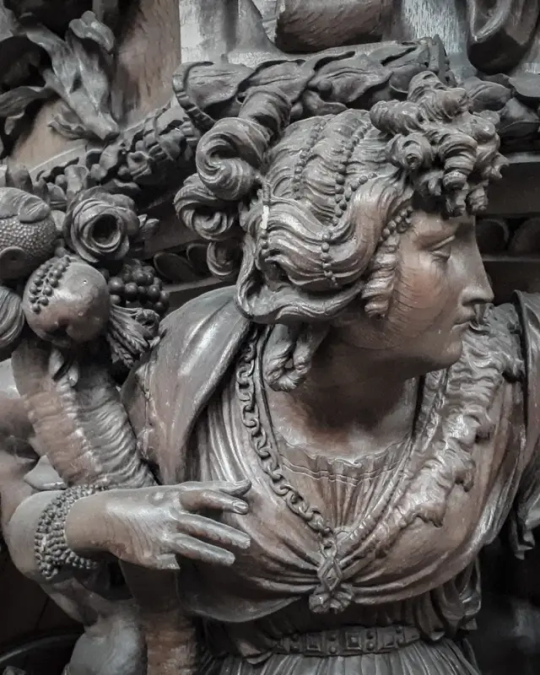
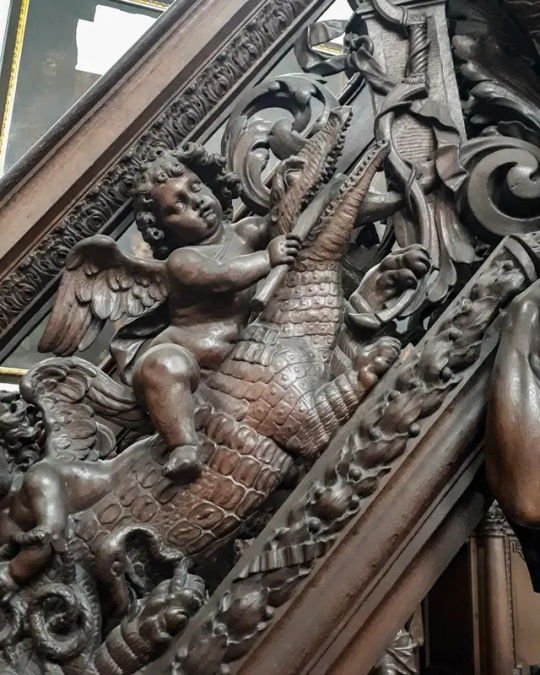

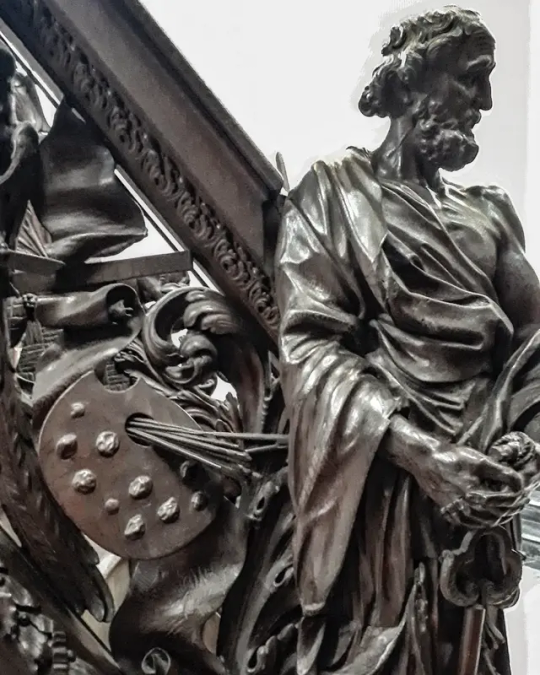
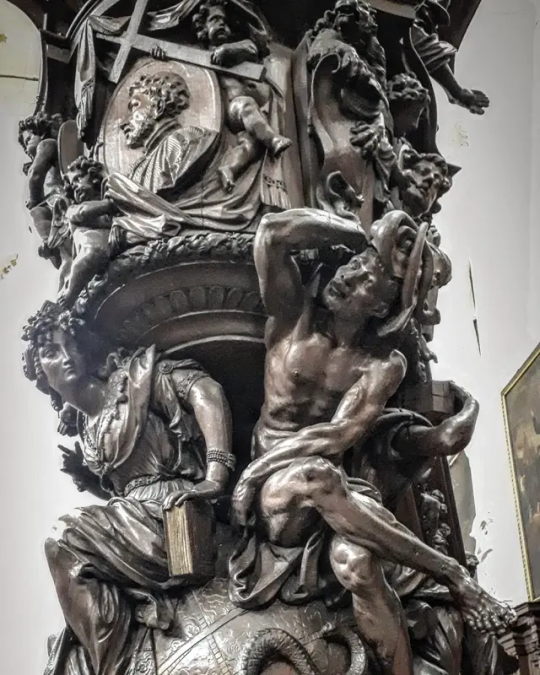




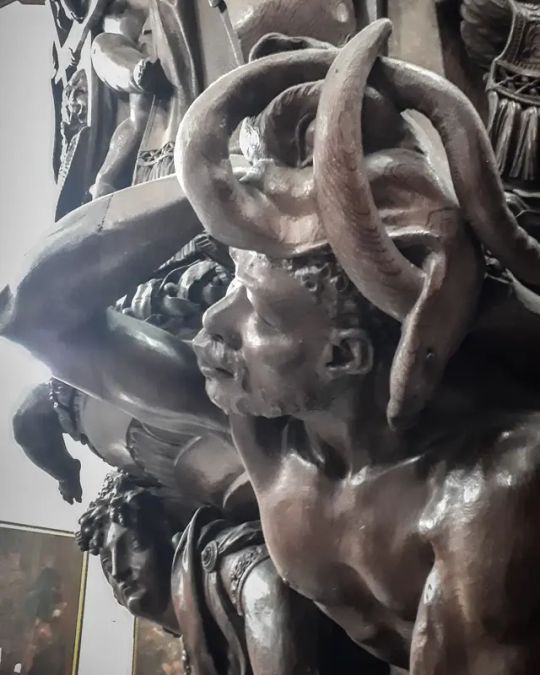
Mechelen was from the late middle ages till the baroque period a centre of woodsculpting. So in this city you can find many top noch furnitures, wood carvings and woodsculptures. Here i present to you the pulpit of the Saint-Peter-and-Paul church (Sint-Pieter-en-Pauluskerk) in Mechelen, Belgium.
The Saint Peter and Paul Church is a former Jesuit church on the Veemarkt in Mechelen. The pulpit, a work by Hendrik Frans Verbruggen (ca. 1700), shows in the form of allegorical figures the spread of the Faith across four continents by the Jesuit Francis Xavier.
The base is a globe resting on crawlers; The globe contains the four then known continents, in the form of persons and characteristic animals:
America: the Indian, turtle and snake
Europa: the young woman with the horn of abundance (cornucopia), a sceptre, a book and a doe
Asia: the woman with a turban and the leopard
Africa: the black one covered with elephant skin, and the crocodile.
Some background on the sculptor Hendrik Frans Verbruggen:
He was born into a family that produced a number of prominent sculptors in the 17th and 18th centuries who were mainly active in Antwerp. His father, the sculptor Pieter Verbruggen, was one of the most important representatives of the Flemish High Baroque in sculpture. The father had been apprenticed to Erasmus Quellinus I, who himself was the founder of a prominent family of sculptors. The father was married to the daughter of his teacher Erasmus Quellinus. From this marriage Hendrik Frans Verbruggen was born. His brother Pieter Verbruggen also became a sculptor and worked in his father's studio.
He was initially trained by his father. However, he is said to have started his career with the book illuminator Jan Ruyselinck. It cannot be ruled out that after his education, like his brother Pieter, he first made a trip to Italy. This journey is not documented. The influence of the Italian sculptor Gianlorenzo Bernini on his work could also be explained by the fact that he used drawings after Bernini's works and antique sculptures that his brother made in Rome as a source of inspiration.
He became a master sculptor with the Antwerp Guild of Saint Luke in 1682. That year he married Susanna Verhulst. He became dean of the Guild of Saint Luke in 1689. In 1713 he went bankrupt, but this did not prevent him from completing existing assignments.
#historical#belgium#history#historical interior#art history#wood sculpture#sculptures#scultura#sculpture#pulpit#wood#oak#fine art#flemish art#flemish#sculptor#churches#church#eglise#iglesia#igreja#chiesa#religious art#mechelen#flanders#brabant#baroque art#baroque#barok#europe
22 notes
·
View notes
Text

#st. francis xavier#Saint francis xavier#saint quotes#catholic saint quotes#catholic#saints#catholicism#tradcath#traditional catholic#love quotes#life quotes#christian quotes#oremus#pax#sanctus#ora pro nobis#catholic saints#catholism#roman catholic#roman catholicism#trenidine mass#tridentine mass#tridentine liturgy#novus ordo#seculorum#dominus vobiscum#sspx#papist#christian#soldier of christ
3 notes
·
View notes
Text

St Francis Xavier Church is a parish Roman Catholic church in the 7th arrondissement of Paris dedicated to Francis Xavier, the patron saint of missions. Built in the late 19th century, It gave its name to the nearby Metro station Saint-François-Xavier.
98 notes
·
View notes
Text
SAINT OF THE DAY (December 3)
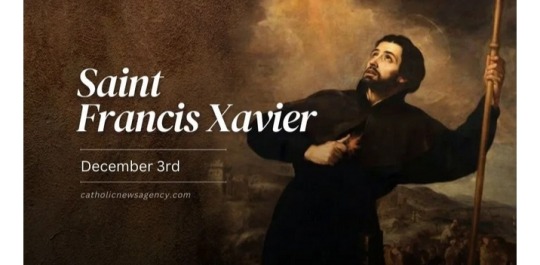
On December 3, the Roman Catholic Church honors St. Francis Xavier, one of the first Jesuits who went on to evangelize vast portions of Asia.
Francis Xavier was born on 7 April 1506 in the Kingdom of Navarre, a region now divided between Spain and France.
His mother was an esteemed heiress and his father an adviser to King John III. While his brothers entered the military, Francis followed an intellectual path to a college in Paris. He studied philosophy and later taught it after earning his masters degree.
In Paris, the young man would discover his destiny with the help of his long-time friend Peter Faber and an older student named Ignatius Loyola, who came to Paris in 1528 to finish a degree and brought together a group of men looking to glorify God with their lives.
At first, personal ambition kept Francis from heeding God's call. Ignatius' humble and austere lifestyle did not appeal to him. But the older student, who had undergone a dramatic conversion, often posed Christ's question to Francis:
“What will it profit a man to gain the whole world and lose his own soul?”
Gradually, Ignatius convinced the young man to give up his own plans and open his mind to God's will.
In 1534, Francis Xavier, Peter Faber and four other men joined Ignatius in making a vow of poverty, chastity and dedication to the spread of the Gospel through personal obedience to the Pope.
Francis became a priest in 1537. Three years later, Pope Paul III confirmed Ignatius and his companions as a religious order called the Jesuits.
During that year, the king of Portugal asked the Pope to send missionaries to his newly-acquired territories in India.
Together with another Jesuit, Simon Rodriguez, Francis first spent time in Portugal caring for the sick and giving instruction in the faith.
On his 35th birthday, he set sail for Goa on India's west coast. There, however, he found the Portuguese colonists causing disgrace to the Church through their bad behavior.
This situation spurred the Jesuit to action. He spent his days visiting prisoners and the sick, gathering groups of children together to teach them about God, and preaching to both Portuguese and Indians. Adopting the lifestyle of the common people, he lived on rice and water in a hut with a dirt floor.
Xavier's missionary efforts among them often succeeded, though he had more difficulty converting the upper classes. He also encountered opposition from both Hindus and Muslims.
In 1545, he extended his efforts to Malaysia, before moving on to Japan in 1549.
Becoming fluent in Japanese, Francis instructed the first generation of Japanese Catholic converts.
Many said that they were willing to suffer martyrdom, rather than renounce the faith brought by the far-flung Jesuit.
St. Francis Xavier became ill and died on 3 December 1552, while seeking a way to enter the closely-guarded kingdom of China.
He was beatified by Paul V on 25 October 1619.
Francis Xavier and Ignatius Loyola were canonized together by Gregory XV on 12 March 1622.
Pius XI proclaimed him the "Patron of Catholic Missions."
11 notes
·
View notes
Text

Happy Feast Day
Blessed Francis Xavier Seelos
1819-1867
Feast Day: October 5
Patronage: against cancer
Blessed Fr. Francis Xavier Seelos was beatified by Pope Saint John Paul II in 2000. Born in Germany, he was inspired to be a Redemptorist missionary priest in the U.S. to serve the German immigrants. At St. Philomena’s Parish in Pittsburgh, he was the assistant to St. John Neumann, who was his spiritual director and encouraged him to preach missions. Fr. Seelos lived a simple lifestyle, serving the poor and abandoned. He was called the “Cheerful Ascetic,” the “American Wonderworker,” the “Doctor of Souls,” for his intercession in healing bodies and souls. He was assigned to parishes in Detroit, Baltimore, and New Orleans, where he died from yellow fever contracted from caring for victims of the disease.
Prints, plaques & holy cards available for purchase. (website)
24 notes
·
View notes
Text

Jack and Caroline leaving mass at Saint Francis Xavier Church in Hyannis.
St Francis Xavier has been a favorite of the Kennedy’s for decades, the parish has held weddings, christenings, and funerals for the family
25 notes
·
View notes
Text
Inquisition Pillar (Haatkatro Khamb)
Located in Old Goa, India. A lone standing pillar of Shiva Temple, Shree Saptakoteshwar that existed during the reign of the Kadamba dynasty, dating back to the 12th century, which was demolished by the Portuguese during their invasion in the 1500s.
Portuguese demolished several temples and used it's relics to decorate their own windows, door frames etc.
This Pillar is one of the many monuments that witnessed atrocities prevailed on Hindus during foreign invasions.
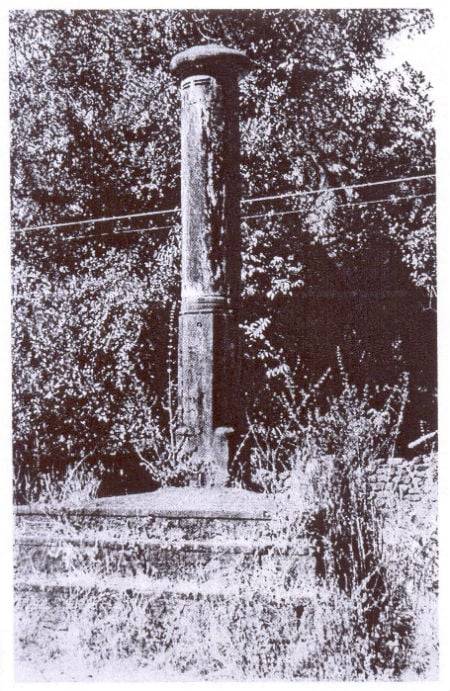
As the name, “Haatkatro” translated to “where hands were chopped”, this pillar was used to chop the hands of thousands (~80k) of Hindus who refused conversion to Christianity and fought against heinous oppression by the Portuguese. 50% of them were Goan Brahmins.
The person who ordered this was Francis Xavier. Hilariously, Hathkatro Khamb is the same place where Christians hold fairs for Xavier, who is regarded as a “Saint” by them. He is rewarded for his brutality and success in conversions.
Several hundreds of Goan Hindus fought against tyrant Portuguese regime with immense bravery, and hence should be remembered as such.
#goa india#portuguese#ancient india#colonisation in india#hinduism#hindublr#desiblr#forced conversion#christian missionaries#hindu temples#hinduphobia#sanatan dharma
66 notes
·
View notes
Text
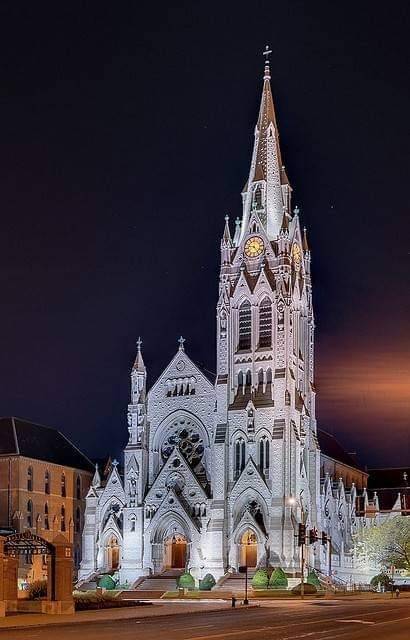
Saint Francis Xavier Church at Saint Louis University in Saint Louis, Missouri, UNITED STATES
#church#iglesia#university#universidad#saint louis#san luis#missouri#united states#estados unidos#north america#norte america#america
75 notes
·
View notes